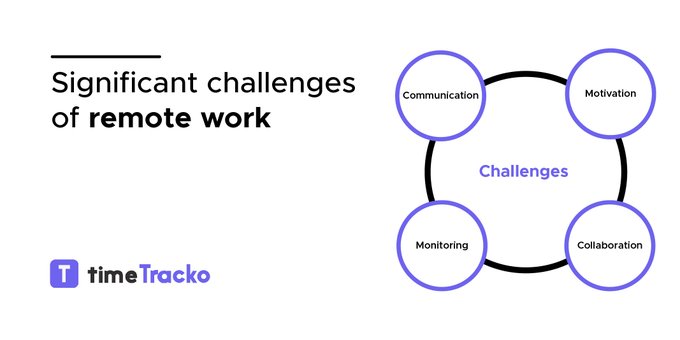Biggest Challenges of Working from Home and Ways to Overcome Them
Biggest Challenges of Working from Home and Ways to Overcome Them
Transitioning to remote work is a massive task, made much more difficult because it occurs overnight due to a global pandemic. For a successful endeavor, organizations developing remote work capabilities must overcome the most common working problems from home.
When considering the various challenges of working from home, the emphasis is frequently focused on how employees may overcome them, but it is crucial to remember that employers face several challenges that must be addressed.
Working from home has several advantages for people who have been opposed to working in offices for most of their lives.
Much has been written about the different benefits of working from home in recent years, but the challenges of working from home also need some attention.
7 Best Challenges of Working from Home

Here I have discussed the biggest challenges of working from home and the tips to overcome those challenges.
Social Isolation

Interacting with other people is a benefit of many occupations. Yes, you’re there to work, but social interaction is crucial and can boost productivity.
According to the American Psychological Association, social isolation has been associated with depression, poor sleep quality, reduced executive function, accelerated cognitive decline, poor cardiovascular function, and decreased immunity.
One of the primary benefits of office-based work is the social element incorporated into the arrangement. While companies do not want any workplace socializing to influence productivity, it is evident that interacting with others regularly is beneficial to workers’ mental health and morale.
Solution
Working from home can cause social isolation, which directly impacts the performance and productivity of employees. Here are some measures to overthrow this issue.
- Communication technology can help with this issue by delivering something like regular work-based social interaction. Microsoft Teams and Zoom, for example, can at least reduce the adverse effects.
- Creating a personal sharing channel might inspire workers to talk about travel, weekend plans, and social activities.
- Plan to play some fun games with team members regularly.
- Appreciate the feedback from every individual working on a project
Minimizing Distractions

At home, there are many distractions. Employees lose attention due to family members, pets, housework, construction, cell phones, TV, and other factors. It is critical to developing a suitable schedule regularly for remote work by detecting and avoiding big distractions.
Some employees do not have home office equipment and may be distracted due to their limited setup.
Some distractions are more appealing than others. Smartphones, for example, are a great opponent when it comes to minimizing the challenges of working remotely.
Having a million social media scrolls at your fingertips is not helpful to productive working. Follow some of the distraction management tips as well.
Solution
Managing a distraction at home can be minimized following some of the following guidelines.
- Set up a signal that alerts others when you are in focus mode. Put “Do Not Disturb” notice at the door so you may not be distracted.
- Explain why it is essential for you to avoid interruptions, stating that they disrupt your attention and make your work ten times harder.
- If you have small children, daycare is necessary unless you plan on working just when they are asleep.
- Motivate your family members to be self-occupied during work hours.
- Maintain constant work hours. Do not answer phone calls at work and, if necessary, makeup meetings.
- If everything else fails, consider working from a co-working space, a library, or a coffee shop.
Prioritizing Work
We don’t have people continually watching over our work or controlling our time; remote employees must be self-motivated time-management gurus.
While it may be challenging for any worker to keep to a plan and manage their to-do list, it is more challenging for remote employees who have more flexible, free-form days and managers in various parts of the world.
Managing your work is difficult enough. Do not spend time on extra activities rather than office work. Make a work schedule so that you have to complete a task in the allocated time. Also, set up a working environment analogous to the office environment.
Solution
Many remote employees struggle with effectively prioritizing duties when it comes to time management. Here are some of the guidelines to prioritize tasks.
- Ensure to complete the most important, lengthiest, and most complex task at the most productive hours of the day, especially in the morning.
- Limit the number of tasks you plan to do every day. Always complete the one time-consuming task first, followed by some medium and small things. This helps to reduce pressure on your head and utilize time better.
- Make a habit of using time tracking tools and distraction management tools on your system to focus on your task better.
Overworking

Closing the workday in a remote setting is not the same as moving away from your desk and leaving the office.
It is challenging to set tight boundaries for when the workday begins and finishes when there is no physical sign.
Overworking is never a healthy thing. Burnout is an actual condition that causes a physical and emotional sensation of tiredness. Attempting to get around this will only compromise performance. And, you don’t want this with your remote workers.
There’s always the possibility that remote employees would relax off when they know their manager isn’t around, but more frequently than not, the reverse happens: they overwork. When there is no distinction between personal and professional life, it might not be easy to take the measures necessary to make that distinction.
Solution
Remote team members can prevent overworking by scheduling appointments for the beginning and end of their days. Here are some more guidelines to overcome overworking issues.
- Set start and end times for your workday and stick to them.
- Start tracking your time. You will be able to see where your time is spent every day.
- Take breaks regularly, which helps to stay focused and productive. So continue to take your lunch break — as well as any other breaks you would have taken if you were in the office — throughout the day. Get up and move away from your workstation if you can, and do something entirely different.
- Schedule an event and set reminders every day so you can stay productive.
Stay Motivated
Staying motivated entails more than simply avoiding distractions. Distraction is just temporary. Concentration loss prevents you from focusing on what you need to focus on and might keep you from succeeding with your work.
On the other hand, staying motivated is a long-term, continuing process. It believes that the task you are doing is worthwhile.
It is essential to believe that your work is meaningful. When things are hectic and unclear, it might be tough to zoom out and consider the long-term company or career goals.
Solution
Here are some of the tips to stay motivated during remote work.
- Set yourself projects and milestones to remind yourself of what you’ve accomplished each day as well as what you’re working for in the long run.
- Break your projects or tasks into smaller chunks. It will simplify your work and helps to motivate you.
- Prepare your workspace similar to the office and stay away from distractions.
- Take regular refreshment breaks so that you can concentrate on your work regularly.
- Always stay in contact with your team members. Have conversations and fun with your colleagues.
- Understand how your actions are helping your team and organization — to achieve targets and remain on track.
Maintaining Team Morale

When you can’t see your colleagues during the day, improving team spirit becomes one of the challenges of working remotely.
Feedback is one approach to increase team morale while also keeping remote workers linked to the company’s goals.
However, your staff should understand that it is not only about the task for you. Demonstrate to your remote team that you support a healthy work-life balance; it’s not all work and no leisure.
It is the responsibility of a project manager to create an environment so that employees fells whatever they are doing is their project which ultimately boosts productivity.
Solution
Keeping up the team morale is one of the biggest challenges of remote work. Here are some tips for maintaining team morale.
- Always try to make team members unique for the assigned projects, so they get encouraged to work better.
- Celebrating team members’ birthdays and achievements is also beneficial in maintaining team morale.
- You have to make remote employees feel that they are more than simply cogs in the machine.
- Spend break times playing online games with team members, which makes them more comfortable working with you.
- Start reward system for the best employee based on overall performance.
Team Communication
Team communication is one of the biggest challenges with remote work. Visiting up to a coworker and asking for information is considered light leg work at an office.
Your mileage may vary in remote teams. Using email, for example, may mean having to wait several hours for a simple ‘yes or no’ inquiry.
Don’t be afraid to reach out to your team in more personal ways. You can utilize applications like Zoom, Slack, and Google Meet. Research to find what works the best suit for your remote workforce.
Communication may be difficult even when you’re in the same physical area, but when you’re not in the same area, you have to express things you probably never thought of before intentionally.
Solution
Here are what you can do to improve team communication.
- Start your day with greetings and standups and set goals for a day.
- Use an instant messaging application such as Teamwork Chat, Troop Messenger, or Slack to stay in touch throughout the day.
- Always use status about what you are doing at the moment.
- Use video calls for meetings and communication.
- Enjoy coffee with colleagues regularly.
Conclusion
While managing remote teams can bring several challenges, many of the challenges that employees face when working remotely may be addressed by employers.
Many of these issues may be resolved with excellent communication and a little technological understanding.
What do you think about the biggest challenges of working from home now for you? Write in the comment section for further discussion.

 in Melbourne
in Melbourne 
 Employee Screen Monitoring Software
Employee Screen Monitoring Software App and Website Monitoring Software
App and Website Monitoring Software Time and Attendance Software
Time and Attendance Software Finance
Finance Banking
Banking Healthcare
Healthcare Lawyers
Lawyers Retail & ecommerce
Retail & ecommerce Knowledge base
Knowledge base Blogs
Blogs Installation Guide
Installation Guide FAQs
FAQs About
About Media Kit
Media Kit Contact us
Contact us